MENU
The Electronic Scholarly Publishing Project: Providing access to classic scientific papers and other scholarly materials, since 1993. More About: ESP | OUR CONTENT | THIS WEBSITE | WHAT'S NEW | WHAT'S HOT
Comparative Timelines
The ESP Timeline (one of the site's most popular features) has been completely updated to allow the user to select (using the timeline controls above each column) different topics for the left and right sides of the display.
Select:
New Left Column
New Left Column
Dates
Decade
New Right Column
New Right Column
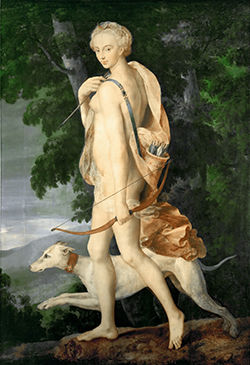 Painting by unknown artist from the school of Fontainbleau: Diana the Huntress This may be an allegorical portrait of Diane de Poitiers, mistress of the French King Henry II. It reveals the profound impact of Italian Mannerist painters on French court art.
Painting by unknown artist from the school of Fontainbleau: Diana the Huntress This may be an allegorical portrait of Diane de Poitiers, mistress of the French King Henry II. It reveals the profound impact of Italian Mannerist painters on French court art.
1550
(no entry for this year)
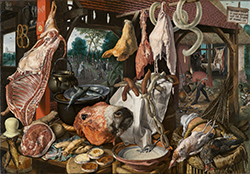 Painting by Pieter Aertsen: A Meat Stall with the Holy Family Giving Alms A large painting, it depicts a peasant market scene, with an abundance of meats and other foods. In the background, it shows a scene from the biblical theme of the flight into Egypt, where the Virgin Mary is seen stopped on the road, giving alms to the poor. Thus, although the painting seems to be at first sight an ordinary still life concentrating on foodstuffs, it is rich with symbolism; it in fact hides a symbolic religious meaning, and embodies a visual metaphor encouraging spiritual life. Aertsen made a name for himself during the 1550s painting scenes from everyday life in a naturalistic manner.
Painting by Pieter Aertsen: A Meat Stall with the Holy Family Giving Alms A large painting, it depicts a peasant market scene, with an abundance of meats and other foods. In the background, it shows a scene from the biblical theme of the flight into Egypt, where the Virgin Mary is seen stopped on the road, giving alms to the poor. Thus, although the painting seems to be at first sight an ordinary still life concentrating on foodstuffs, it is rich with symbolism; it in fact hides a symbolic religious meaning, and embodies a visual metaphor encouraging spiritual life. Aertsen made a name for himself during the 1550s painting scenes from everyday life in a naturalistic manner.
1551
(no entry for this year)
(no entry for this year)
1553
(no entry for this year)
(no entry for this year)
1554
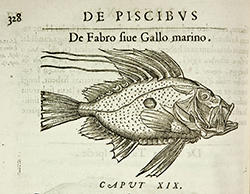 Guillaume Rondelet publishes a volume on Mediterranean fish — De Piscibus — and includes the assertion that glossopetrae, or tongue stones, resemble shark teeth. The hypothesis attracts little attention.
Guillaume Rondelet publishes a volume on Mediterranean fish — De Piscibus — and includes the assertion that glossopetrae, or tongue stones, resemble shark teeth. The hypothesis attracts little attention.
Roman naturalist Ippolito Salviani publishes History of Aquatic Animals.
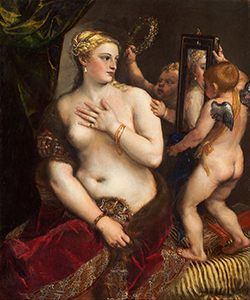 Painting by Titian: Venus with a Mirror The pose of the Venus resembles the classical statues of the Venus de' Medici in Florence or the Capitoline Venus in Rome, which Titian may have seen when he wrote that was "learning from the marvelous ancient stones." The painting is said to celebrate the ideal beauty of the female form, or to be a critique of vanity, or perhaps both. It was copied by several later artists, including Peter Paul Rubens and Anthony van Dyck. Titian made a number of paintings of the same subject, but this is the believed to be the earliest and the only version to be entirely by the hand of Titian, without additions by his assistants. it remained in his house until his death in 1576. X-rays of the painting have revealed that Titian painted it over a double portrait which he had abandoned.
Painting by Titian: Venus with a Mirror The pose of the Venus resembles the classical statues of the Venus de' Medici in Florence or the Capitoline Venus in Rome, which Titian may have seen when he wrote that was "learning from the marvelous ancient stones." The painting is said to celebrate the ideal beauty of the female form, or to be a critique of vanity, or perhaps both. It was copied by several later artists, including Peter Paul Rubens and Anthony van Dyck. Titian made a number of paintings of the same subject, but this is the believed to be the earliest and the only version to be entirely by the hand of Titian, without additions by his assistants. it remained in his house until his death in 1576. X-rays of the painting have revealed that Titian painted it over a double portrait which he had abandoned.
1555
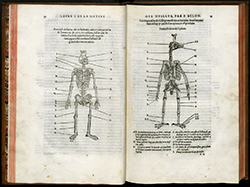 Pierre Belon publishes L'Histoire de la nature des oyseaux, a pioneering work in the comparative anatomy of birds.
Pierre Belon publishes L'Histoire de la nature des oyseaux, a pioneering work in the comparative anatomy of birds.
(no entry for this year)
1556
(no entry for this year)
(no entry for this year)
1557
(no entry for this year)
(no entry for this year)
1558
(no entry for this year)
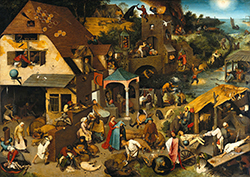 Painting by Pieter Bruegel the Elder: Netherlandish Proverbs a 1559 oil-on-oak-panel painting that depicts a scene in which humans and, to a lesser extent, animals and objects, offer literal illustrations of Dutch language proverbs and idioms. Running themes in Bruegel's paintings are the absurdity, wickedness and foolishness of humans, and this is no exception. The painting's original title, The Blue Cloak or The Folly of the World, indicates that Bruegel's intent was not just to illustrate proverbs, but rather to catalog human folly. Many of the people depicted show the characteristic blank features that Bruegel used to portray fools.
Painting by Pieter Bruegel the Elder: Netherlandish Proverbs a 1559 oil-on-oak-panel painting that depicts a scene in which humans and, to a lesser extent, animals and objects, offer literal illustrations of Dutch language proverbs and idioms. Running themes in Bruegel's paintings are the absurdity, wickedness and foolishness of humans, and this is no exception. The painting's original title, The Blue Cloak or The Folly of the World, indicates that Bruegel's intent was not just to illustrate proverbs, but rather to catalog human folly. Many of the people depicted show the characteristic blank features that Bruegel used to portray fools.
1559
(no entry for this year)
ESP Quick Facts
ESP Origins
In the early 1990's, Robert Robbins was a faculty member at Johns Hopkins, where he directed the informatics core of GDB — the human gene-mapping database of the international human genome project. To share papers with colleagues around the world, he set up a small paper-sharing section on his personal web page. This small project evolved into The Electronic Scholarly Publishing Project.
ESP Support
In 1995, Robbins became the VP/IT of the Fred Hutchinson Cancer Research Center in Seattle, WA. Soon after arriving in Seattle, Robbins secured funding, through the ELSI component of the US Human Genome Project, to create the original ESP.ORG web site, with the formal goal of providing free, world-wide access to the literature of classical genetics.
ESP Rationale
Although the methods of molecular biology can seem almost magical to the uninitiated, the original techniques of classical genetics are readily appreciated by one and all: cross individuals that differ in some inherited trait, collect all of the progeny, score their attributes, and propose mechanisms to explain the patterns of inheritance observed.
ESP Goal
In reading the early works of classical genetics, one is drawn, almost inexorably, into ever more complex models, until molecular explanations begin to seem both necessary and natural. At that point, the tools for understanding genome research are at hand. Assisting readers reach this point was the original goal of The Electronic Scholarly Publishing Project.
ESP Usage
Usage of the site grew rapidly and has remained high. Faculty began to use the site for their assigned readings. Other on-line publishers, ranging from The New York Times to Nature referenced ESP materials in their own publications. Nobel laureates (e.g., Joshua Lederberg) regularly used the site and even wrote to suggest changes and improvements.
ESP Content
When the site began, no journals were making their early content available in digital format. As a result, ESP was obliged to digitize classic literature before it could be made available. For many important papers — such as Mendel's original paper or the first genetic map — ESP had to produce entirely new typeset versions of the works, if they were to be available in a high-quality format.
ESP Help
Early support from the DOE component of the Human Genome Project was critically important for getting the ESP project on a firm foundation. Since that funding ended (nearly 20 years ago), the project has been operated as a purely volunteer effort. Anyone wishing to assist in these efforts should send an email to Robbins.
ESP Plans
With the development of methods for adding typeset side notes to PDF files, the ESP project now plans to add annotated versions of some classical papers to its holdings. We also plan to add new reference and pedagogical material. We have already started providing regularly updated, comprehensive bibliographies to the ESP.ORG site.
ESP Picks from Around the Web (updated 06 MAR 2017 )
Old Science

Weird Science

Treating Disease with Fecal Transplantation
Fossils of miniature humans (hobbits) discovered in Indonesia

Dinosaur tail, complete with feathers, found preserved in amber.
Astronomy

Mysterious fast radio burst (FRB) detected in the distant universe.